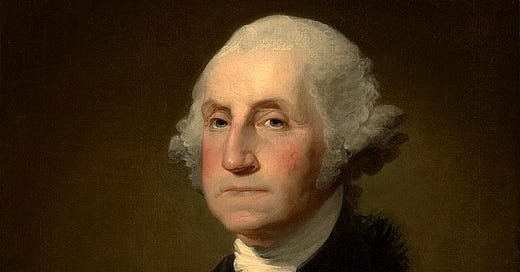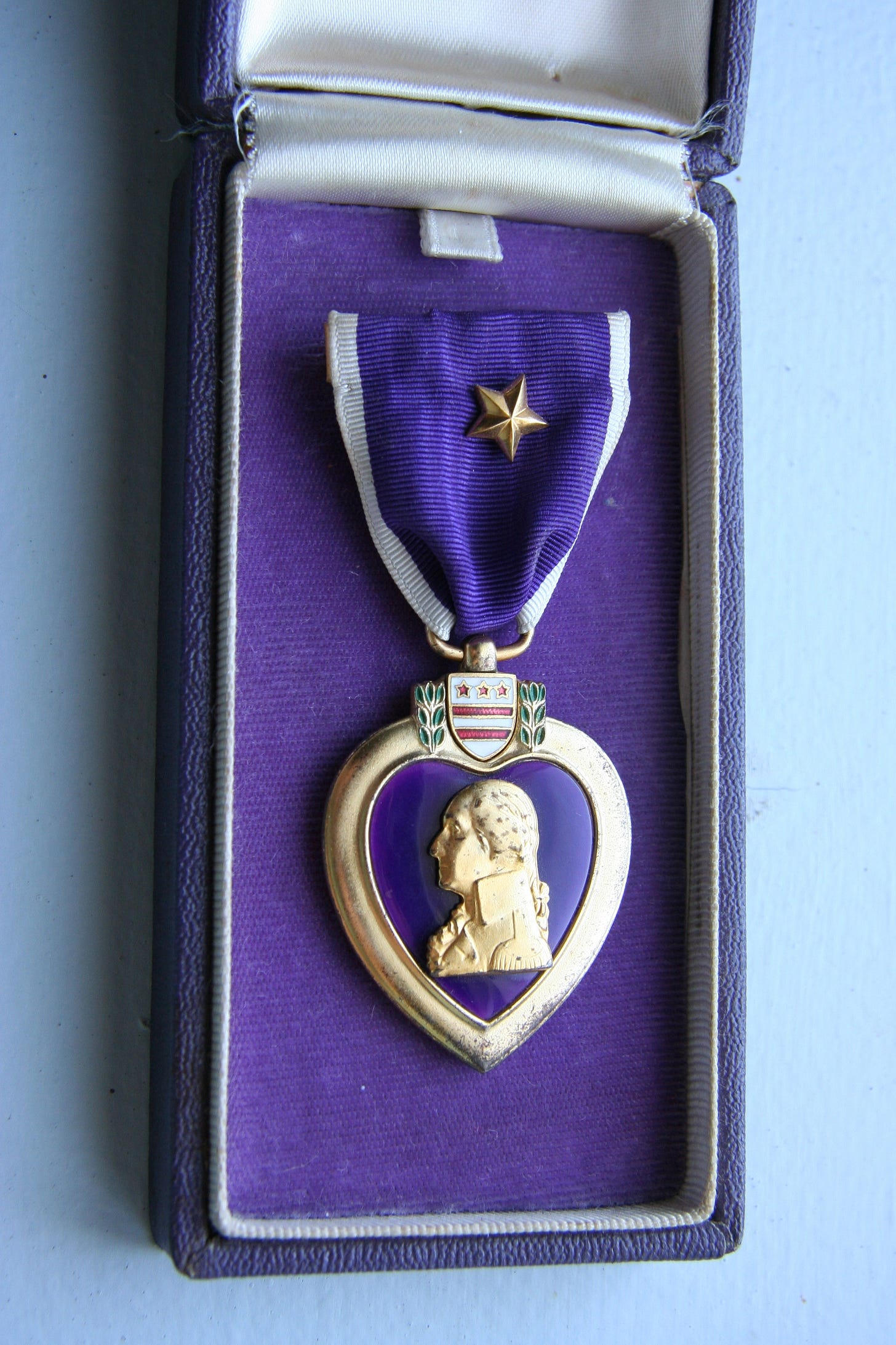“Badge for Military Merit” Created this Day in History
On this day in history, 1782, the "Badge for Military Merit," was created by…..
Today, I received an email about events which had taken place in the history of our great nation. I thought it would be a good idea to share one of these events, since it has a lot of meaning, memories, family ties, to a lot of people.
“Badge for Military Merit" (1782):
George Washington, the first President of the United States, created the "Badge for Military Merit," which later evolved into the Purple Heart medal, honoring wounded and fallen soldiers.
The Badge of Military Merit was an award for non-commissioned officers and soldiers of the Continental Army. It is largely considered America's first military decoration, and the second oldest in the world (after the Cross of St. George). Non-commissioned officers and soldiers of the Continental Army were eligible. Now known as the Purple Heart Medal, it was redesigned and re-commissioned in 1932 by General Douglas MacArthur in honor of George Washington’s bicentennial.
The Badge of Military Merit was first announced in General George Washington's general orders to the Continental Army issued on August 7, 1782, at the Headquarters in Newburgh. Designed by Washington in the form of a purple heart, it was intended as a military order for soldiers who exhibited, "not only instances of unusual gallantry in battle, but also extraordinary fidelity and essential service in any way".
The writings of General Washington indicate that three badges, two Honorary Badges of Distinction and a Badge of Military Merit, were created on August 7, 1782. This is thought to be the first time in modern history that military awards had been presented to common soldiers. Though the French Royal Army had started awarding the Medallion of Two Swords to enlisted soldiers for longevity in 1771, the general practice in Europe was to honor high-ranking officers who had achieved victory, rather than honoring common soldiers. But in America, as General Washington said, the "road to glory in a patriot army and a free country is…open to all".
On August 7, 1782, Washington issued a general order detailing the badge:
The General ever desirous to cherish virtuous ambition in his soldiers, as well as to foster and encourage every species of Military merit, directs that whenever any singularly meritorious action is performed, the author of it shall be permitted to wear on his facings over the left breast, the figure of a heart in purple cloth, or silk, edged with narrow lace or binding. Not only instances of unusual gallantry, but also of extraordinary fidelity and essential service in any way shall meet with a due reward. Before this favour can be conferred on any man, the particular fact, or facts, on which it is to be grounded must be set forth to the Commander in chief accompanied with certificates from the Commanding officers of the regiment and brigade to which the Candadate for reward belonged, or other incontestable proofs, and upon granting it, the name and regiment of the person with the action so certified are to be enrolled in the book of merit which will be kept at the orderly office. Men who have merited this last distinction to be suffered to pass all guards and sentinals which officers are permitted to do. The road to glory in a patriot army and a free country is thus open to all. This order is also to have retrospect to the earliest stages of the war, and to be considered as a permanent one.
Most historians indicate that only three people received the Badge of Military Merit during the American Revolutionary War, all of them noncommissioned officers, and the only ones who received the award from General Washington himself. Those soldiers are as follows:
On May 3, 1783
• Sergeant William Brown of the 5th Connecticut Regiment of the Connecticut Line
• Sergeant Elijah Churchill of the 2nd Regiment Light Dragoons
On June 10, 1783
• Sergeant Daniel Bissell of the 2nd Connecticut Regiment of the Connecticut Line
Period records, however, indicate that several others may have been awarded the Badge of Military Merit for service in the American Revolutionary War.
Brown's badge was found in a Deerfield, New Hampshire barn in the 1920s. There is disagreement in published sources about what became of Brown's badge after that. A badge on display at the American Independence Museum in Exeter, New Hampshire on behalf of the Society of the Cincinnati, New Hampshire Branch is stated to be Brown's. Other sources say that Brown's badge was reported lost in 1924 while in the possession of Bishop Paul Matthews, and that the badge on display in Exeter belongs to a fourth, unknown recipient.
As of 2015, Churchill's badge was owned by the National Temple Hill Association and on display at the New Windsor Cantonment State Historic Site. Churchill's badge was rediscovered when H. E. Johnson, a Michigan farmer and one of Churchill's descendants, wrote to the National Temple Hill Association about the badge.
Bissell's badge was reportedly lost when his house burned in July 1813.
After the Revolutionary War, the Badge of Military Merit fell into disuse although it was never officially abolished. In 1932, the United States War Department authorized the new Purple Heart Medal for soldiers who had previously received either a Wound Chevron or the Army Wound Ribbon. At that time, it was also determined that the Purple Heart Medal would be considered the official "successor decoration" to the Badge of Military Merit.
Purple Heart decoration (Wikimedia image)
Purple Heart decoration in presentation case, awarded to a United States Army soldier in World War II (By Jonathunder/Wikimedia image)

References
This article, and images were taken, mostly in part, as written from the following Wikipedia.com articles:
https://en.wikipedia.org/wiki/Badge_of_Military_Merit
https://en.wikipedia.org/wiki/Purple_Heart
Notes
1. Although the Fidelity Medallion is older, it was awarded for a specific event, so the Badge of Military Merit is generally considered the oldest United States military award.
Sources
1. Phoenix, J. (August 7, 2007). "The 225th Anniversary of the Purple Heart". West Point Association of Graduates. Retrieved October 15, 2009.
2. Wescott, Allen Pennell (Autumn 1941). "For Military Merit". Military Affairs. 5 (3): 211–214.
3. "The George Washington Papers at the Library of Congress, 1741–1799". George Washington, August 7, 1782, General Orders. August 7, 1782. Archived from the original on January 8, 2016. Retrieved October 1, 2006.
4. Honorary Badges of distinction are to be conferred on the veteran Non-commissioned officers and soldiers of the army who have served more than three years with bravery, fidelity and good conduct; for this purpose a narrow piece of white cloath of an angular form is to be fixed to the left arm on the uniform Coat. Non-commissioned officers and soldiers who have served with equal reputation more than six years are to be distinguished by two pieces of cloth set in parellel to each other in a simular form; should any who are not entitled to these honors have the insolence to assume the badges of them they shall be severely punished. On the other hand it is expected those gallant men who are thus designated will on all occasions be treated with particular confidence and consideration. George Washington's General Orders of August 7, 1782.
5. "MÉDAILLON DES DEUX ÉPÉES". France-phaleristique - Ordres et Décorations de France. Marc Champenois. Retrieved August 7, 2023.
6. Moran, Donald N. "Medals and Awards of The Revolution". Sons of Liberty Chapter: Sons of the American Revolution. Retrieved May 26, 2010.
7. Fitzpatrick, John C. The Writings of Washington from the Original Manuscript Sources, 1745–1799. Washington, D.C.: Government Printing Office, 1931–1944; reprint, New York: Greenwood Press, 1970.
8. "The George Washington Papers at the Library of Congress, 1741–1799". George Washington, April 27, 1783, General Orders. April 27, 1783. Archived from the original on January 8, 2016. Retrieved October 1, 2006.
9. "The George Washington Papers at the Library of Congress, 1741–1799". George Washington, June 8, 1783, General Orders. June 8, 1783. Archived from the original on January 8, 2016. Retrieved October 1, 2006.
10. Grosvenor, Gilbert Hovey (1944). Insignia and Decorations of the U.S. Armed Forces (Rev. ed.). Washington, D.C.: National Geographic Society.
11. Wescott, Allen Pennell (1941). "For Military Merit". Military Affairs. 5 (3): 211–214.
12. The Legacy of the Purple Heart. Vol. 2 (4th rev. ed.). Paducah, Kentucky: Turner Publishing Co. 2001. p. 19.
13. "Personal Decorations: Purple Heart". The Institute of Heraldry. Office of the Administrative Assistant to the Secretary of the Army. Archived from the original on August 16, 2016. Retrieved July 14, 2016.










We thank our brave soldiers for their courage, sacrifices and service. May we be forever grateful to them and may we honor them by upholding our democratic Republic.